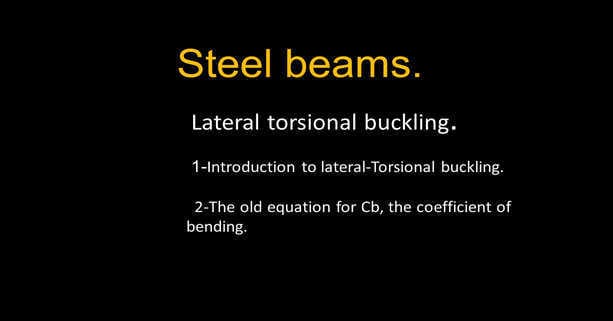Last Updated on June 17, 2024 by Maged kamel
Lateral-Torsional Buckling For Beams.
A new subject, which is about the Lateral-torsional buckling of beams, a torsion will occur for a beam accompanied by a lateral movement; refer to the definition from Schaum’s book, Structural Steel Design. Topics included in the content
Introduction to lateral-torsional buckling for steel beams.
We talked earlier about lateral buckling for both the flange and the web of a beam and that lateral buckling depends on lambda coefficients. Lambda value λ is affected by the width and thickness of the flange, the height of the web, and the thickness of the web; this is a new subject.
Suppose we have a beam that is braced at the two ends. Due to the load, the bending moment will create horizontal movement and rotation, as you can see.
I quote from Prof. Salmon’s chapter 9. Consider the compression zone of the laterally unsupported beam of Fig. 9.1.1, which can buckle laterally. The beam is held at the two ends.
Point A and Point B are equally stressed. Imperfection in the beam and accidental eccentricity in loading results in different stresses at A and B, furthermore, residual stresses as discussed in Chapter 6 contribute to unequal stresses across the flange width at any distance from the neutral axis.
Due to residual stresses from the variation between cooling and heating during the fabrication process, the compression flange moves, accompanied by resistance from the tension bottom flange, which is why we have a rotation.
Another definition from Schaum’s book, I quote, as the name implies, is lateral-torsional buckling, which is the overall instability condition of a beam involving the simultaneous twisting of the member and lateral buckling of the compression flange.
Due to torsion, the compression flange of the I beam moved laterally. However, the lower flange moved a smaller lateral distance, lateral buckling occurred, and the line passing by the web has an angle φ with the original web line.
To prevent Lateral-torsional buckling, a beam must be braced at certain intervals against either the cross-section’s twisting or the compression flange’s lateral displacement.
The interaction of the compression and tension flanges forces an unrestrained beam to twist. The resistance to this twist depends on the beam section’s torsional resistance.
From the IDEA statiCA link, beams with large flange thicknesses, for example, have greater torsional resistance than those of lesser flange thicknesses for any given depth. Other sections also offer more excellent resistance (RHS/SHS), which are often used when large spans are needed to carry the vertical load (e.g., openings involving bi-fold doors), which are prone to out-of-plane force effects.
This is why an adequate number of bracings with proper spacing is required, unlike the bracing of the column, which requires member framing into the column.
The moment will have components: Mo, Mo cos φ. Referring to the top view, a curvature occurs taking a section at A-A that shows the moment in the x’ and y’ directions.
Secondary beams can help minimize the lateral-torsional buckling effect for beams, as shown in the next slide picture.
The effect of bracing on steel beams will be discussed. In post 17, a new factor, the Cb factor, which is the coefficient of bending for beams, will be presented. In the next post, we will discuss the different regions for Lateral-torsional buckling for beams.
For a valuable external source, Chapter 8 – Bending Members.
The next post will be the Regions for Lateral-torsional buckling for beams.

